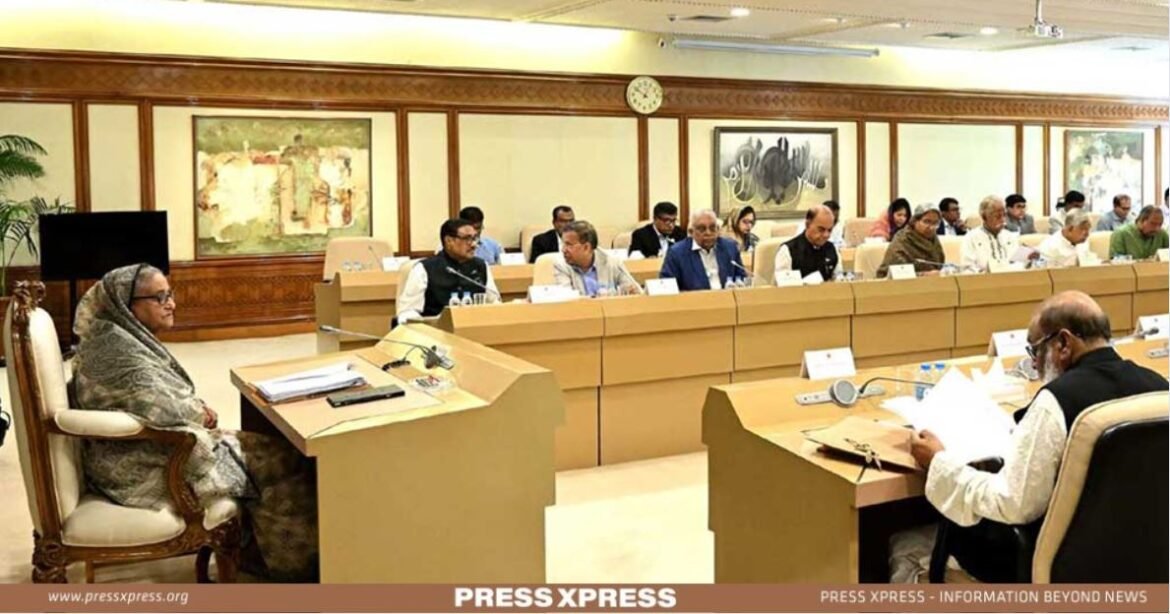Prime Minister Sheikh Hasina has issued a resounding call for stricter oversight of the daily necessities market, decrying the unjustifiable price surge despite an apparent abundance of supply. “Market monitoring must be intensified to curb these unwarranted price escalations,” emphasized Cabinet Secretary Md Mahbub Hossain, echoing the premier’s sentiment following the Cabinet Meeting on May 20, 2024.
You can also read: Sustainable Reintegration Project, A Beacon of Hope for Returned Migrant Workers
Leading the session from her office, Prime Minister Hasina left no room for ambiguity as she directed comprehensive measures to rein in the soaring prices. With the weight of her authority, she underscored the urgency of the situation, demanding proactive steps to halt the unjustifiable inflation.
Food Inflation Hits Four-Month High in Bangladesh
Meanwhile, amidst the fervor of governance, the Cabinet made pivotal decisions, including the endorsement of a bill outlining the salary and perks for the chief election commissioner (CEC) and other commissioners. Additionally, it greenlit a policy for the prestigious ‘Bangabandhu Sheikh Mujibur Rahman Peace Medal’, slated to commence in 2025.
Yet, amidst these deliberations, the specter of inflation looms large. The latest figures from the Bangladesh Bureau of Statistics paint a stark picture, with food inflation hitting a four-month high of 10.22% in April. Traders, seizing on the opportunity, have hiked prices of essential commodities, attributing the surge to the recent uptick in dollar rates.
As per the Trading Corporation of Bangladesh (TCB) data on May 20, the prices of key items like garlic, turmeric, ginger, and others have witnessed a notable spike over the past week. This trend, exacerbated by the looming Eid-ul-Azha festivities, reflects a systemic vulnerability that some unscrupulous traders exploit for personal gain.
Traders have raised prices of essential imported food items, such as edible oil, sugar, pulses, and raw materials for poultry feed, citing the recent increase in dollar rates.
Stubbornly High Inflation Rates
In the realm of economic dynamics, Bangladesh finds itself amid a tapestry of inflationary challenges, standing out prominently among its regional counterparts. Surpassing neighbors except Pakistan’s formidable 20.7% inflation rate in March, Bangladesh grapples with the highest inflationary pressure, casting a shadow over the nation’s economic landscape. By comparison, India navigates a more modest 4.85% point-to-point inflation, while Sri Lanka treads cautiously with a 2.5% inflation rate in the same period—an intricate dance of economic fluctuations across South Asia.
Central to the orchestration of economic stability lies the pivotal role of central banks, wielding monetary policy as a potent instrument to steer nations towards desired GDP growth trajectories while taming the voracious beast of inflation. In this symphony of monetary governance, the Bangladesh Bank assumes a venerated position, mirroring its global counterparts in the solemn pursuit of economic equilibrium.
Comparative Regional Inflation Data:
- Bangladesh: 10.22%.
- Pakistan: 20.7%.
- India: 4.85%.
- Sri Lanka: 2.5%.
However, the stark dissonance between policy aspirations and ground realities is unmistakable. Despite the issuance of two resolute monetary policy statements aimed at curbing inflation to a manageable 7.5% within the current fiscal year, the Bangladesh Bureau of Statistics unveils a harsh truth—hovering close to 10% throughout the year, inflation remains a formidable adversary, defying attempts at containment.
The narrative unfolds further with a stark juxtaposition of official exchange rates and market realities, where the yawning chasm between stated rates and practical application exposes fissures within the economic edifice. Despite official pronouncements, businesses find themselves grappling with the stark reality of higher LC rates, exacerbating financial strain amid burgeoning inflationary pressures. Meanwhile, the parallel market paints a bleaker picture, with the USD commanding prices exceeding Tk120—a testament to the market’s relentless logic in the face of regulatory attempts.
Economic Realities Clash with Policy Goals
In a bid to stem the tide of inflation, the Bangladesh Bank embarks on a course of action characterized by interest rate hikes—a tactical maneuver aimed at recalibrating economic equilibrium. The policy rate’s ascent to 8% in the Monetary Policy Statement for H1 of FY24 echoes this resolve, triggering a ripple effect across the financial landscape. Consequently, the call money market witnesses a commensurate rise in interest rates, culminating in an overall bank interest rate surge to 13.55% in April—a testament to the far-reaching implications of monetary policy adjustments.
Yet, beneath the veneer of policy pronouncements lies a deeper undercurrent of economic dynamics, where liquidity fluctuations mirror the ebb and flow of market sentiments. The specter of excess liquidity dissipates gradually, ensnared by a web of factors ranging from deposit withdrawal pressures to waning confidence in the banking sector—a sobering reality underscored by central bank data tracing the decline from Tk1,81,090 crore in July last year to Tk162,061.35 crore in February this year.
Amidst this economic flux, the latest monetary policy delineates a strategic blueprint, setting ambitious private-sector credit growth targets aimed at constraining inflation by curbing money supply. However, the yawning chasm between policy imperatives and economic actualities is starkly evident, as dwindling private sector credit growth in February bears testament to the chilling effect of inflationary pressures on investment sentiments—an ominous harbinger of economic headwinds ahead.
In these economic ebbs and flows, experts discern deeper systemic vulnerabilities, where opportunism intersects with market dynamics, potentially eroding the ethos of fair trade. The surge in demand for spice products ahead of Eid-ul-Adha serves as a microcosm of this phenomenon, wherein economic imperatives collide with ethical considerations.


